The MiG Saga
1st part The propeller aircrafts
French Version HERE
The Mikoyan Design Bureau (OKB MiG Osoboye Konstruktorskoye Buro ) is a producer of military aircraft used by USSR during WW2 and after by the VVSF and its allied during Cold War
The Design Bureau was founded in December of 1939 with A.I. Mikoyan, M.I. Gurevich, and V.A. Romodin,,
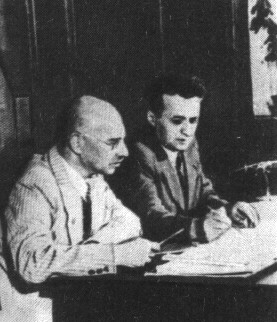 |
| Mikoyan, M.I. Gurevich |
The first design team, was the I-200 fighter aircraft, renamed MiG 1( Mkoyan i Gurevich – the was in Russian language like and.)
But MiG-1 (a batch 100 aircrafts was produced was not a very good plane because it suffered from poor maneuverability armor, and armament, and had a very limited range; in fact,
Little after basing on an improved design, appear the MiG 3 ; He was an excellent high-altitude interceptor, produced at 3233 devices He remain in service throughout the war.
In 1941, the Design Bureau was moved to Samra former Kuibyshev after German advance MiG Team work upon an improved MiG-3 design with a new engine the AM-37. However, the AM-37 was promptly discontinued, dooming the MiG-7 prototype to be both the first and last of its kind. But the new MiG 9 (a MiG 3 airframe with a radial engine ) suffer from poor handling and excessive vibrations so only 5 were ever built.
In 1942, the Design Bureau return in Moscow, and began work on more advanced aircraft types.
The I-300 or also called MiG-9 powered by Soviet copies of a BMW Jet engine flight in 1946 and he was the Soviets' first jet-powered aircraft
Several improved version of the MiG 9 called Fargo by NATO to were produced, before the Mig 15 Falcon
MiG 15 was an advanced jet aircraft armed with 3 cannon introduced in 1948.MiG-15, powered by a copied RR Nene engine, and he was opposed to American F 86 Sabre over Korea,18,000 were produced, more than any other jet fighter in history.
Design Bureau continued to advance the MiG line, introducing MiG 17'Fresco' in 1952, the supersonic MiG 19 farmer in 1956 and the MiG21 Fishbed in 1959 MiG-21 was built in China as F-7 the MiG 25 Foxbat in 1964 , the MiG 23 Flogger in 1969, which boasted improved ground attack capabilities, and the MiG 27 in 1973 are pure ground-attack variant of the MiG-23, also called 'Flogger' by NATO The high-altitude performance of the MiG-25 so alarmed the West
The MiG 31 Foxhound a high-performance redesign of the MiG-25, introduced in 1975 and the MiG 29 Fulcrum The MiG-29 was the Mikoyan Design Bureau's most recent designs and it is an extremely agile air superiority fighter.
Future of the Mikoyan Design Bureau and its projects are somewhat in doubt due to the situation of the actual Russia An advanced fighter was under development as the MiG-42, but sine to day he was always on the design projects .
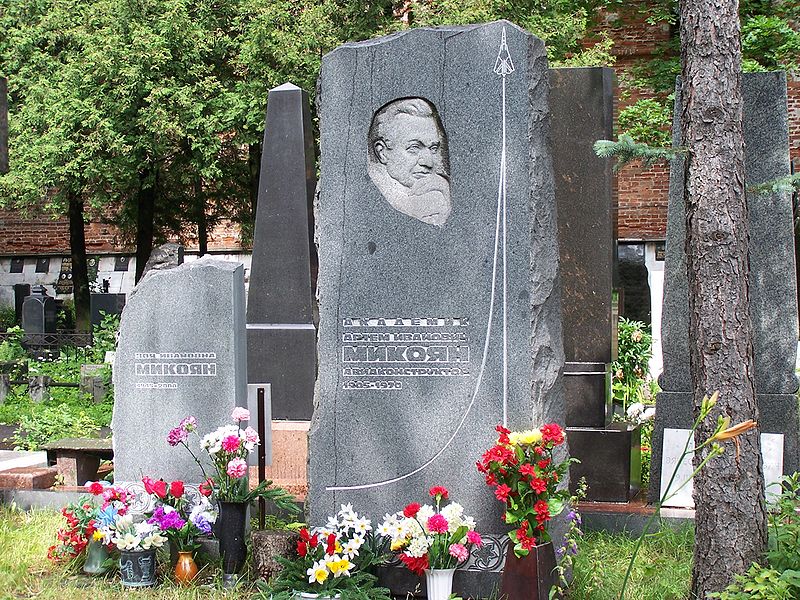 |
| Mikoyan Grave (1905 1970) |
MiG propelled Aircrafts
Mig 1 Микоян-Гуревич МиГ-1
The MiG-1 (Микоян-Гуревич МиГ-1) was the first built by the Design Bureau during WW2. He foreshadow the MiG3 bat with its poor maneuverability and inadequate armour and a limited range he was not a very good plane . But with its design MiG prove to be able to built a capable high-altitude interceptor aircraft and this first air craft forme the basis for the future MiG 3, which established a reputation for its Design Bureau and its designers.
History
The MiG 1 development began in 1938 with a project t for a I single-seat interceptor in competition with the KH project from NN Polikarpov
The AM 35 V engine who was one of the most powerful engines in the world in its category in this time was choose for this design Starting with 2 projects at the end only one project born th I-200( Istrebitel (Fighter))
The I 200
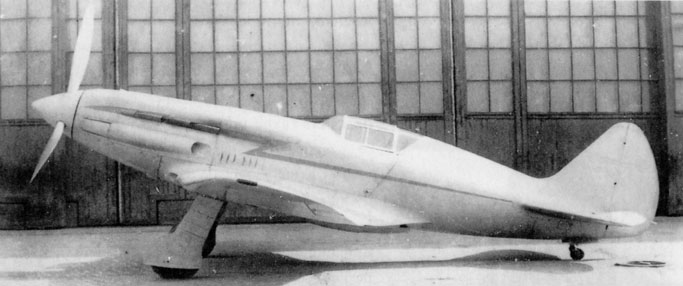 |
The I 200 was an ahead small slim low-wing monoplane with retractable landing gear. Airframe and covering were composite, wood and metal.
Work on I-200 drawings began on November 25th 1939. But project X was equipped with the Mikulin AM-35 engine because the AM-37 was not yet ready for production
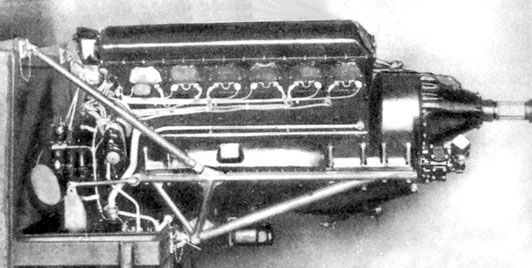 |
| AM 35 |
AM-35A had the same dimensions, but its power was 200 hp lower.
The drawings were completed and were submitted to the authorities on December 1939, and on 25 December the mockup was completed and approved;
Tests ( TsAGI T-101 wind tunnel ) are concluded on January 1940 and confirmed the good aerodynamic shape of the airframe, even if they judged that the project performances were a bit optimistic.
Government offices gave to Mikoyan the date of July 1st, 1940 as a deadline for state acceptance trial. But he was very difficult to achieve in time this program because they had started slowly, and in the same time Lavockin I-301 and Yakovlev I-26 projects already had months of advantage in development time.
Thanks to the help of technicians of Zavod 1 and his experience as production technician, Mikoyan divided the I-200 into some sub-assembies that could be produced separately and then easily assembled together by a small number of simple connections; this modular conception was favourable both for mass production and for maintenance, allowing to quickly remove and replace a damaged sub-assembly even in field conditions.
Wide use was made of casted and moulded pieces, which were particularly apt for mass production. All the detail drawings were completed by February 1940; there were only 2500 pcs, thank to the simplifiation created by the use of moulded parts.
 |
 |
| i 200 |
He flight for the first time on April 5th 1940 with Arkadij Ekatov in Moscow and on 1st May 1940 Ekatov flew the I-200 n.01 over Moscow's Red Square.
Description
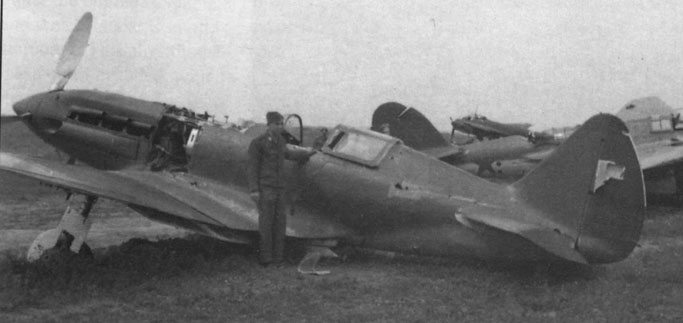 |
The length was l 8,15 m with a canopy conformation in an one-piece windshield, a rightward opening shield, a short clear rear part
bulges and intakes over the nose were absent; only the lower bulge under the nose, containing the cooler and lubrification pumps, was present
there was a predisposition for guns installations with recessed outlets (instead than partially protruding as on MiG-1 and 3)
the small inlets for ignitors and the one on the low-left part of the nose were absent, as the cooling slots in front of the windshield; the central one under the nose was particularly small; the small intake in right-low position was present
There are some minor differences in panels division, particularly the exhaust shields and the panels with 6 slots . the tail wheel door had not any bulge nor window;
the underwing removable panels for guns pods ammo were absent
the supercharger intakes at the wingroots were different than those of MiG-3, particularly for having a shorter upper lip
the water radiator fairing was different to those of MiG-3, and apparently smaller than those of no.02 and 03
The main landing gear were different from MiG-3; they had smaller wheels, different doors shape, and foldable wheel flaps as on I-16, instead of the wheel doors as on MiG- 3
the oil cooler was installed only on the left side of nose, and the shutter is on his air inlet rather than on the outlet; it was the only I-200 with this configuration
the aircraft was painted silver, and it had a red lightning painted on both his sides
Propeller blades were unpainted alumimium.
But gradually serious faults appear
lack of maneuverability (due to small overloaded wings),
limited range
weak protection and armament (actually all those are payment for small size).
poor spin performance (several fatalities) due to back-shifted center of gravity.
On the other hands this aircraft proved to be an excellent performer as interceptor with ng 648.5km/h on May 24th at the height of 6,900 m; the only faster semi-operative aircraft was the Heinkel He-100
Despite this problems aircraft was placed into production but these problems caused production to be limited to 100 aircraft
In the some time test were conduced wtihe the Ip 201
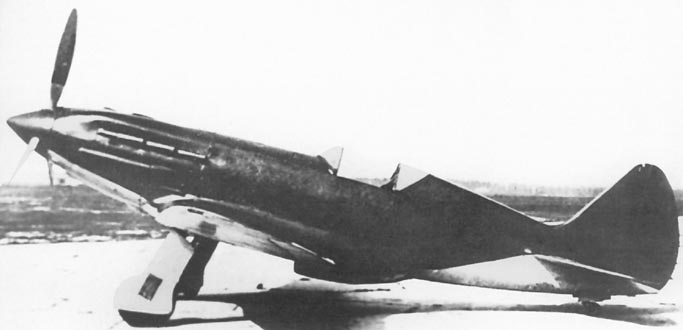 |
| i 201 |
A new test aircraft was built the IP-201 who was an I-200 armed with 2 guns MP-3 (PTB-23) of 23 mm caliber, with 60 rounds each, and two ShKAS 7,62 mm, with 750 rounds each In the same time to to enlarge the fuselage tank capacity to 195 l an increase alos the range of the aircraft the UBS 12,7 mm gun was removed
This new gun (MP3 ) was projected by J.G. Taubin and M.N. Baburin of the OKB-16 NKV,( narodniy komissariat vooruzheniy - People's Commissariat of Weapons ) were installed on underwing pods.In the same time 2x 100 kg bombs could be carried too.
Installed on a mockup aircraft armament was tested on June 1940, and July a commission of ANPK (Aviatsionnyy nauchno-proizvodstvennyy kompleks approved it but on August VVS, instead, stated that the rate of fire of MP3 guns (300 rounds for minute) was unacceptably low, and proposed the installation of BS 12,7 mm guns with 300 rounds each instead. On October1940, ANPK (Aviatsionnyy nauchno-proizvodstvennyy kompleks) ordered at NKV to study the possibility to placing MP-3 guns instead of the ShKAS on the I-200 nose,
The conclusion was that both the gun and the syncronizer needed significant modification to work. The installation of guns on the wings, however, didn't require as much modification so on October 1940 amockup aircraft, equipped with a gun on its left wing, was trasmitted to NKAP and OKB-16 modified the MP-3 into the MP-6, able to fire 600 rounds for minute .
This modifications were approved and it was ordered to develop underwing pods for MP-6 23 mm gun and AP 12,7 mm gun, both designed by Taubin and Baburin.
Works on I-200 no.03 were completed with strenghtened and modified outer wing panels, But MP6 guns cause visible flexing of the wings.At the end of November aircraft N° 3 was ready but on December test pilot made a forced landing damaging the aircraft, that was sent to repair. On March 1941 factory tests ceased, because the MP-6 and AP guns failed and didn't enter service; Taubin and Baburin were shot for their failure.
This problems of the MiG 1giving way to the radically modified aircraft the MiG3
Description
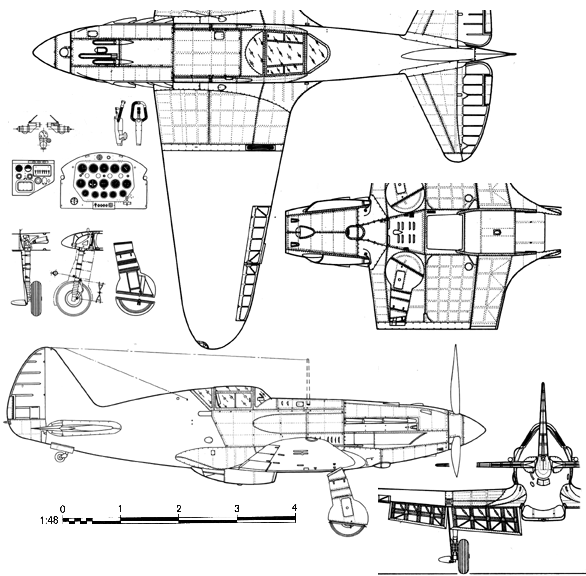 |
MiG-1 was used for ground attack - but it was rather misuse of good high altitude interceptor with limitations in low altitude performance. It is not clear if all the aircrafts were at this point equipped with the rearward-sliding canopy, or if some of them had still a hinged canopy as with the prototypes. All (except few early batches) were equipped with protected fuel tanks.
The aircraft has a length of 8,15 m exhaust stack is slightly overposed to the rear side plate
We found 7 ventilation slots on each side instead than 6 as on early series MiG-3 and some bulges and intakes over the nose were absent, and a small air intake under the nose was smaller the tail wheel doors are without any bulge or window
the underwing removable panels for guns pods ammo were absent
the water radiator fairing and main landing gear were different from MiG-3; they had smaller wheels, different doors shape, and foldable wheel flaps as on I-16, instead of the wheel doors as on MiG-3
The supercharger intakes at the wingroots had shorter lips, particularly the upper ones.
MiG 1 in Action
By the end of 1940, all 100 MiG-1s were built, and the first 20 of them were delivered to the VVS( Военно-воздушные силы or Voenno-Vozdushnye Sily ) within the year, with the rest delivered in early 1941. The first operative units to receive the new aircraft were 31st IAP at Kaunas Air Base, in Lithuania, and 41th IAP at Belostok Air Base, in Soviet-occupied Poland. Large numbers of MiGs were captured because most Soviet pilots were not fully comfortable or trusting of the new MiG’s tricky flight characteristics,, and preferred to evacuate the airfields or combat flying older types, such as I-153 and I-16.
The MiG 3 Микоян-Гуревич МиГ-3
 |
The Mig 3 was the development of the MiG1
On October 1940 o SKF resolution required the increase of the range of new fighters to 1,000 km, at the 90% of maximum speed, measured with fuel contained in internal tanks only. A new version of the I-200 was ordered
To be on the specifications I-200 will be have
a new self-sealing tank with a capacity of 250 l was installed under the fuselage to increase fuel capacity but the water cooler was moved aft and replaced with a larger one, now an OP-310 to find place for the tank in the time predisposition for external auxiliary tanks was deleted to save weight, and to balance the new tank, the engine mounts were lighter
The prototype was ready for the factory tests on October 21st 1940 and it flew on October 29th 1940,
At the end of November the aircraft was sent to the South to have best weather condition for the purpose to conduct joint testing with NII-VVS.
According to order n° 707 of the ANPK (Aviatsionnyy nauchno-proizvodstvennyy kompleks) of December 9th older version was officially named MiG-1, and the new version MiG-3,
Little after MiG-3, was put into production on December 20th 1940, starting with machine number 2101 (101st series aircraft); the modification created some chaos in the three production lines
It was decided to build 3500 MiG-3 in Zavod 1 Moscow-Vnukovo during the year 1941 after the production of the 100 MiG-1 built up to mid December, 1940 20 MiG-3 in late december 1940, and 150 MiG-3 in January 1941 .During February the production increased, and in March it 1941 it reached a rate of 70 per week; In March 473 MiG-3 were built, of which 270 were already sent to operative units.
At that time, they considered producing the new version of the fighter at Zavod No.21 in Gorkiy (now Nizhniy Novgorod) , and to start the production in Kiev Zavod no.43, where it was projected to build 100 further MiG-3s during 1941. This latest production line was never started.
Aviation repair depots in Riga were adapted for the MiG-3 maintenance.
But is this aircraft was of an exceptional easy maintenance, repairability and part compatibility. It was sais that generally from 2-3 unrepairable machines one flying could be assembled in the field conditions. , this new fighter issued from line production was different from the prototype MiG-3s built on this period were slower and rougher than prototypes, and prone to many types of faults
Aircrafts were tested and after it was was sure that Mig 3 have not the range of 1000 km range required but only 820
After modifications Tests conducted on April 19 by Zavod 1 on two series aircrafts confirmed the results of the calculation, giving a flight range of 1180 km.
But the program for the modernization of the fighter line met a lot of troubles, partly due to excessive hurry. The aircrafts delivered to the operative units revealed a lot of constructive defects,
The government feared that the program had to be considered failed aand he research culprit Mikoyan, was brother of Anastas Mikoyan, Commissar for Foreign Trade and all the responsabilities are put upon General A.I. Filin who was sent to a military tribunal where Artyom Mikoyan himself deposed against him, and then shot Additionally, many section chiefs of NII-VVS were removed from their posts. All of them were unjustifiably accused of sabotage and hindering the introduction of new aircrafts.
.jpg) |
| 1925 Ordzhonikidze Stalin Mikoyan ( father) |
Even if N.N. Polikarpov was not persecuted, this investigation contributed, aside the I-180 failure, to his total loss of influence, and to the move of him and his team from Moscow to Novosibirsk, where he continued to work on some excellent projects that had not any productive result
Description
 |
This new aircraft was a MiG 1 modificated
the former aircrafts had many defects weak armament, tendency to spin, longitudinal instability and high landing speed: so the new aircraft must correct them
We found under all the defects of the MiG 1/3
First the pilot has difficulties to open canopy at speeds over 400 km/h, and this led pilots to usually fly with the canopy open, that reduced the speed by 30 km/h
Landing gear often failing to extend, and easy to be damaged during landing
Difficulty to repair damages to the carburetor duct after a belly landing; this could stop to the ground the aircraft for a long time for repair
difficulty to repair internal structures of the rear fuselage, because the stabilizator was solidal to them and limited their accessibility
Unsatisfactory view, particularly during takeoff and landing, due to the long nose and strongly nose-up asset on the ground
Some splashing of oil on the windscreen reduced the visibility
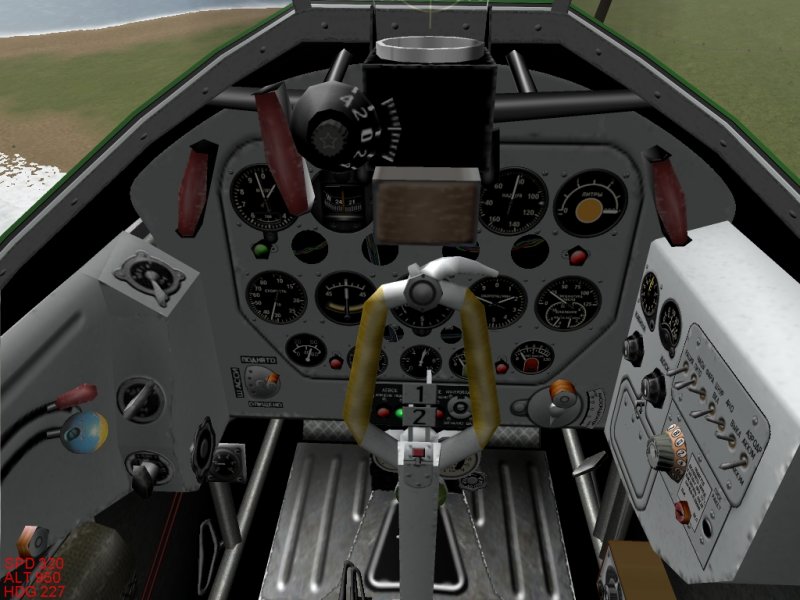 |
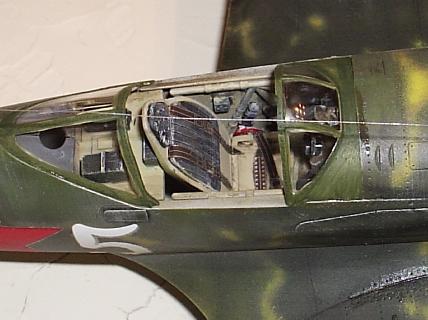 |
| internet |
High cockpit temperature, due to the ventral cooler
Fumes and, eventually fuel vapors in the cockpit
Lack of a fuel flow indicator
Low range, particularly with canopy opened, that reduced its utility as a reconaissance plane
Unsatisfactory engine acceleration that caused accidents
Fall of oil pressure while diving with a negative G load.
Modifications were made and later after he MiG-3 was an high altitude fighter aftet some mofications .Retrofitting an automatic mixture control on the carburetor, modifying the oil and fuel pumps to avoid loss of pressure at high altitude, and to install reliable oxygen equipment.
.gif) |
The 55th IAP unit of the future top ace A. Pokryshkin, was impressed by the new fighter, particularly for its capability in vertical manoeuvres
The range and the request for a 1000 km range penalized the MiG-3 increasing their weight; The only fighter from the Yakovlev OKB that conformed to it was the I-30, that remained as only a prototype. On May 10, 1941, the ventral tank was reduced from 250 l to 140 l to save weight.
On July 1941, automatic slats were introduced, noticeably improving the flight characteristics with regards to spinning. The introduction of slats led to moving the pitot probe from the right wing edge to the lower right wing surface.
The engine In the seconf half of 1941 the engine gear was modificated an he receive olso a new AV-5L-123 propeller instead of VISh-22E
.jpg) |
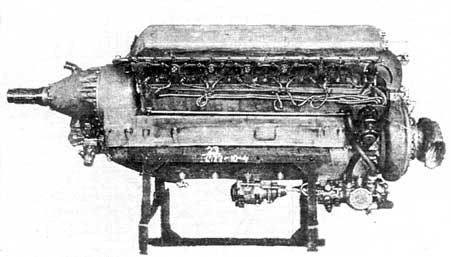 |
| AM 37 |
AM 37 |
This new propeller blades had a pitch angle range of 30° instead of 20°
Late MiG-3s could have both gear ratios; the installed one was painted on the cowling side to avoid mistakes while mounting the propeller.
An armoured glass was installed internally to the windshield.
The engine cowling with was considered unsatisfactory and too complex by first line units;
According to this, a new cowling inspired to that of Bf-109 was tested at first on the aircraft n.2554, and then introduced into series production from the 16th series (each series was usually composed of 100 aircrafts, so the new cowling should be installed from the aircraft n.3600).
 |
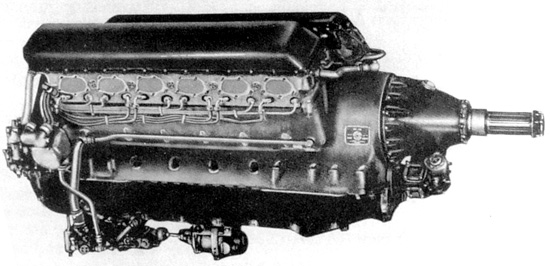 |
| AM 35 |
AM 38 |
But the cessation the Mikouline AM 35 motor for the Mikouline Am38 who motorize the Iliushine Il 2 spop the MiG 3 production.
The horizontal stabilizators were modified, apparently enlarging their chord at the tip.
During the summer 1941, tests were made on many armament combinations
2 UBS and 2 ShKAS (ШВАК: Шпитальный-Владимиров Авиационный Крупнокалиберный, Shpitalnyi-Vladimirov Aviatsionnyi Krupnokalibernyi )
2 UBS and 1 ShKAS
2 UBS.
Then, from September 20, Zavod 1 produced 315 MiG-3s armed with two 12,7 mm UBS guns with 700 rounds each; of these, 215 examples were armed with two ZROB-82 underwing batteries with 3 ROS-82 rockets each.
Further previously-built examples were refitted with rocket launchers too.
Studies for arming the MiG-3s with a 2 gun armament were made frome the end of 1940, and the 23 mm ShVAK gun was identified as the most apt; but, due to the war, it was not possible to install such armament in 1940. The last 52 examples, built in Kuibyshev and in Moscow, were armed with a couple of ShVAK.
Project s of some versions of MiG 3
MiG-3 with Trapezoidal wing
Version proposed in August 1941 with installation of trapezoidal wingtips on the MiG-3, for decrease the landing speed of about 5 km/h
All was rejected, because such a small improvement couldn't justify trouble in a full working assembling line
MiG-3 AM-38
One weak point of the MiG-3 was its poor performance at low altitudes, where the most of air combat took place.
To remedy to this, the aircraft n.3595 was equipped with an AM-38F engine with a takeoff power of 1600 hp and a AV-5L-110A propeller.
The aircraft made its maiden flight on July 31, 1941, and conducted tests for the following 12 days. Test pilots Y.K. Stankevich and chief engineer K.N. Mkrtychan were assigned to the test program.
The greater power improved by much the aircraft's performances, particularly maximum speed, up to the altitude of 4,000 m.
While the AM-38 F engine could easily replace the AM-35A without structural modifies, the cooling system revealed to be insufficient for this more powerful engine, and this limited the operability of the aircraft to temperatures not higher than 16°C on the ground
This aircraft was tested in two configurations: one the original made by Zavod 1 aircraft reached 582 km/h at 3400 m altitude and the second one incorporated some modifies proposed by the chief designer: new design of the fairings of the exhaust stacks, bomb shackles removed and inert gas system installed. while in the second configuration it reached 592 km/h..
After the test in NII, the aircraft returned in Zavod 1 for modifies, but after this the aircraft gave problems with the supercharger, and during a flight the aircraft suffered deformation of fuel tanks.
Aircraft returned to the factory for repairs. In the aircraft flew again but the aircraft crashed killing the test pilot An investigation showed that the cause of this was a combat with an enemy aircraft.
But if this engine gave higher power but less altitude capability than the AM-35A aircraft had a significant improvement in its low-altitude performance, and outclassed even the Bf-109F.
Trials showed the necessity to redesign the oil and water radiators because of the higher heat generation of the new engine, and as well, the Il-2 program was proprietary for the use of the AM-38 engine. Because of these factors, the program was halted.
A pair of other MiG-3s during November 1941were re-engined in such way in operative units.
The characteristics are a small pipe on the left side, collecting inert exhaust from the 2nd and 3rd stacks of the exhaust pipes for anti-flame inert gas system of the fuel tanks Exhaust pipes similar (if not identical) to the series examples; the aircraft carried two different configurations for exhaust stacks
Photo-reconnaissance MiG-3
During July 1941, five aircrafts were modified in Zavod 1 with the installation of an AFA-I camera.
Lightened MiG-3
In 1943, two MiG-3s were modified by NII-VVS to increase their ceiling. One of the aircrafts was lightened of 187 kg, passing to a loaded mass of 3098 kg; its ceiling increased to 11750 m.
Pressurized MiG-3 (project XS)
Before the war, a pressurized cockpit was required for I-200 and I-153; the chief designer of Zavod 482, A.Y. Tserbakov developeed three versions of the pressurized cabin. Due to the starting of the war, the project was abandoned.
MiG-3 SPB for Zveno
The SPB composite dive bomber, Zveno, was a carrier aircraft TB-3 with two I-16 fighter armed with two 250 kg bombs each
the fighters were carried by the TB-3, then they were released for the final attack and they return back (hopely) on their own or carried again by the TB-3; this allows to attack objectives by far beyond the range of an usual bomber.
An updated Zveno considered the use of a Pe-8 four-engine bomber and two MiG-3s with bombs. Dduration of flight about 5 hours. Flying range at 5,000 m: 1320-1450 km, with the fighters engines nourished by the fuel of the bomber
The project was abandoned due to the heavy workload of the factories.
MiG-3 with additional wing
In 1941, designer A.A. Senkov proposed to install an additional retractable canvas wing on MiG-3s to reduce landing speed.
The proposal was not accepted because the increased weight and drag would deteriorate the flight characteristics.
MiG-7 (izdelye 72)
During April 1941, the engine AM-37 was approved for series production. A MiG-3 equipped with an AM-37 engine was built and named MiG-7.
The first flights revealed a poor longitudinal stability, that would require wide reprojecting of the aircraft. The AM-37 engine was removed from the MiG-7 to be installed on the DIS-200 (MiG-5) heavy fighter prototype. In June 1941 the beginning of the war led to abandoning the project, because of the priority of AM-38F production for Il-2.
I-210 MIG-9 and I-211 MiG-9E
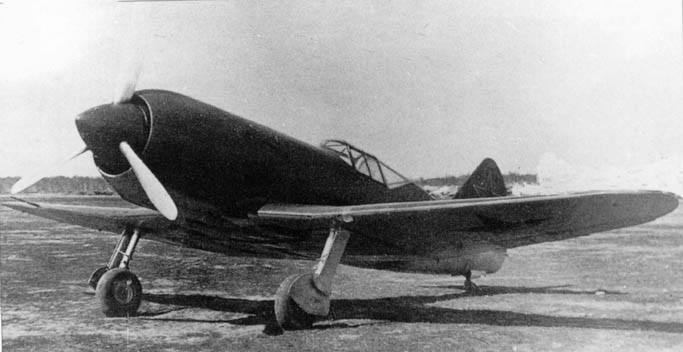 |
On late 1942, works began on a new derivative powered by the improved M-82F engine, that in 1943 was renamed ASh-82F in homage to its designer Arkady Shvetsov . All the previous experiences on MiG-9 were taken into account, as well as the TsAGI recommandations.
A great effort was made to reduce mass and drag -5prototyps with M-82A motor and 10 dix prototypes with M-82F motor( Mig 9E)
Other projects on I-211 base
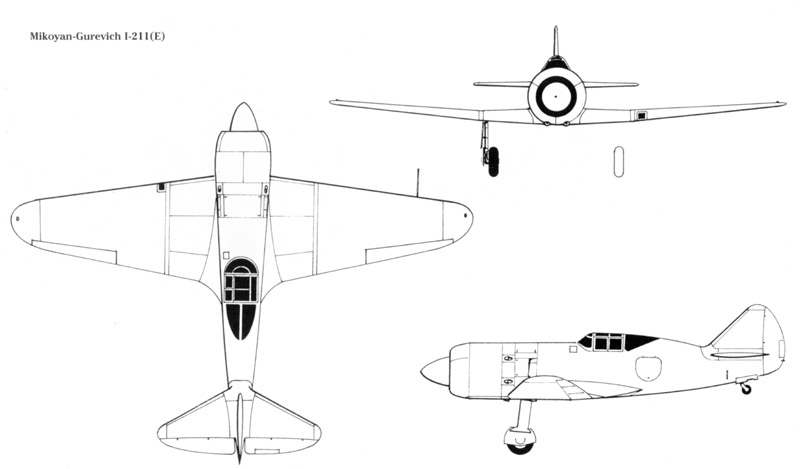 |
In February 1943, OKB-155 studied the installation of the large 18 cylinders two-row air cooled M-90 engine, able of 2000 hp, developed by OKB-29. And in March 1944, OKB-155 studied the installation on I-211 of the U.S. engine Pratt&Whitney R-2800-63 and General Electric S-23 turbocompressor, ( both installed on the fighter Republic P-47 D-10RE "Thunderbolt" supplied by USA. )
With a maximum power of 2250 hp, the aircraft should reach 740 km/h at 10,000 m altitude, and a ceiling of 14,500 m; the full loaded weight should be 3,800 kg. On April 1944 project were presented to NKAP, but they never turned into a prototype.
I-230 MiG-3U (uluchshennyi, improved).
On February 26, 1943 the OKB was charged to develop an improved MiG-3 for the PVO, with the following requirements
take off weight 3100 kg
top speed 670 km/h;
ceiling 12500 m;
climb time to 10,000 m 13 minutes
six prototypes with wooden frame and AM-35. Motor were built
I-231 -
prototype issued drom the I-230, with AM-39 motor
Mig 5
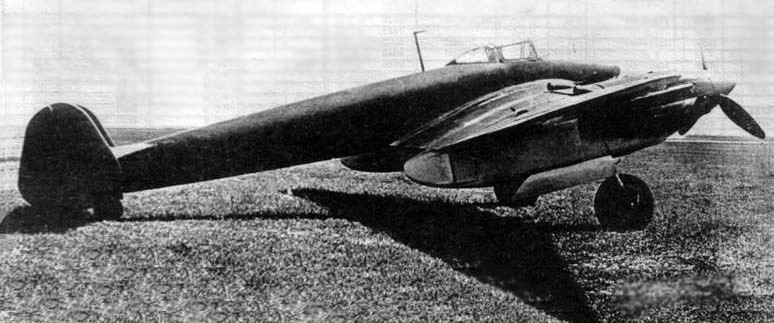 |
| AA20 |
 |
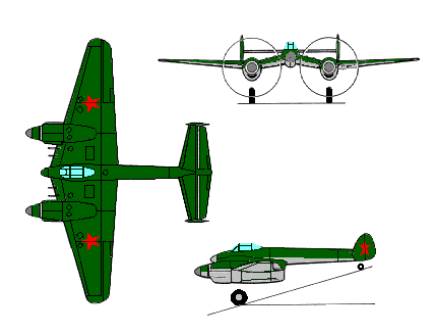 |
| MiG 5 |
MiG 5 |
Operational career
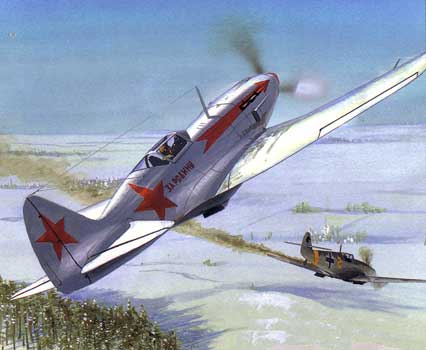 |
| Internet |
MiG-3s were delivered to front-line fighter regiments beginning in the spring of 1941 and proved to be a handful for pilots accustomed to the lnext generation of soviet aircraft like Polikarpov I 6 I 152 or I 153
So like MiG has a flew very differently than the older fighters ,many fighter regiments were not diligent in training their pilots to this new aircraft
On 1 June 1941 1,029 MIG-3s were on strength, but there were only 494 trained pilots
At the beginning of Barabarossa operation most MiG-3s and MiG-1s were in the border military districts of the Soviet Union.
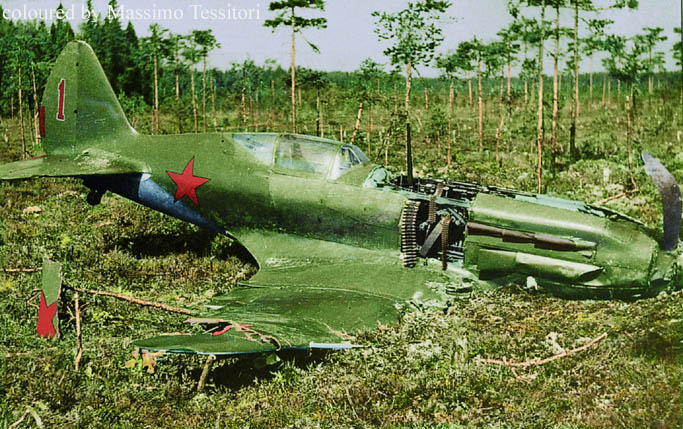 |
| Internet |
Leningrad Military district had 164,
Baltic military district had 135
Western special Military district had 233
Kev Military District had 190
Odessa Military district had 195
Total of 917 on hand, of which only 81 were non-operational.
64 MiG were assigned to Naval Aviation, 38 in the Air Force of the Baltic Fleet and and 26 in the Air Force of the Black sea fleet
Most of the MiG-3s assigned to the interior military districts were transferred to the PVO
( ProtivoVozdushnaya Oborona or "Anti-Air Defense ) where their lack of performance at low altitudes was not so important.
On 10 July 299 were assigned to the PVO,while only 293 remained with the VVS and 60 with the Naval Air Forces.
A total of only 652 despite deliveries of several hundred aircraft
. By 1 October, on the eve of operation Typhoon the German offensive against Moscow 257 were assigned to VVS units, 209 to the PVO and 46 to the Navy a total of only 512, a decrease of 140 fighters since 10 July, despite deliveries of over a thousand aircraft in the intervening period.
By 5 December, the start of the Soviet counter-offensive that drove the Germans back from the gates of Moscow, the Navy had 33 MiG on hand, the VVS 210 and the PVO 309 This was a total of 552, an increase of only 40 aircraft from the 1st of October.
Over the winter of 1941–42 the Soviets transferred all of the remaining MiG-3s to the Navy and PVO
On May 1942 Naval Aviation had 37 MiGs on strength while the PVO had 323
On June 1944 the Navy had transferred all its aircraft to the PVO,
On January 1945 some remain in training units and none were assigned to combat units by that date.
Colours schema
.jpg) |
Summer shema
All the early series production MiG-1s and MiG-3s were painted with
AII green uppersurfaces, light blue undersurfaces;six red stars (often contoured in black) on fuselage sides, wing upper and undersurfaces.propeller blades were left unpainted aluminium, with partially black painted rear surface, often very worn off by air abrasion.The pitot probe was light, probably light blue, with unpainted aluminium end This scheme was common for MiG-1s and early MiG-3s, till the war outbreak.
This way to paint MiG-3s was abandoned more or less contemporarily to the war outbreak, and to the introduction of late type MiG-3.
Winter schema
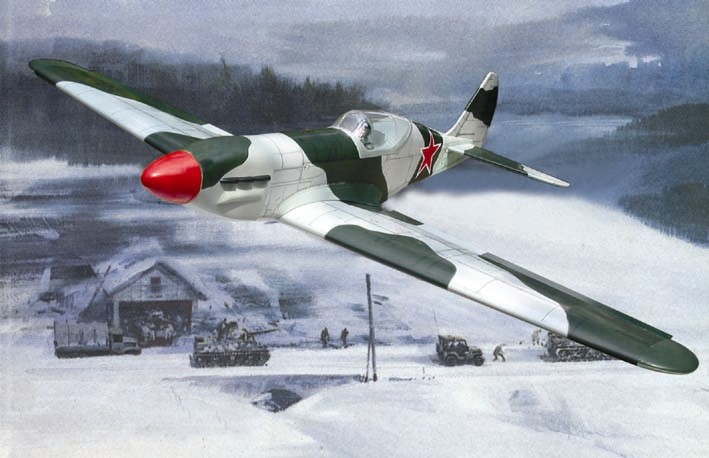 |
| Internet |
During the snow period, many MiG-3 were painted white, both on the factory and on the field.
The white cote had a different look depending by the mean of application (spray or brush), of the layer thickness, the wearing, the care etc.
On many examples, it appeared as a very light grey instead that pure white.
Besides, a lot of MiG-3s were fully repainted with summer schemes during the spring of 1942, and this let us know that the white layer wasn't too easy to be removed.
The white paint could cover the upper and side surfaces only, or be extended to the lower surfaces too.
The white paint extends often on propeller spinner and blades, and even on the exhaust stacks (that return quickly dark because of heat and smoke).
While summer camouflaged MiG-3s wore usually numbers on the fuselage side, in front of the stars, white MiG-3s wore them on the stabilizer, or don't have them at all. Very few exceptions to this rule were seen.
By the winter 1941/42, most MiG-3s had their tail wheel locked in extracted position, the doors removed and a tissue cover added to close the bay.
RS-82 rockets were a standard equipment for the MiG-3s operating in the front of Moscow.
.jpg) |
| Internet |
Some rare photos show MiG-3s partially covered with white distemper; they could be of winter 1942, for analogy with similarly painted LaGG-3s.
Repainting
There is no standard schemes were due to many types of repainting
The use of field made camouflaged started at the war outbreak, usually on the base of the old solid green painting.
In some cases the field camo was very similar to the factory applied one, ie large bands of dark green or black.
Other aircraft were painted in more fanciful way, forthemost with thin mottling or striping of black on a green base; many photos exist of such arrangement, but they show forthemost the aircraft in too partial way.
 |
| Germain Painting |
Photoscopes Walk Around MIG 3 ICI HERE






.jpg)


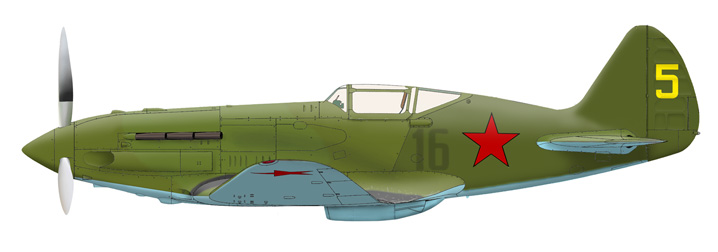








.jpg)



.gif)
.jpg)








.jpg)

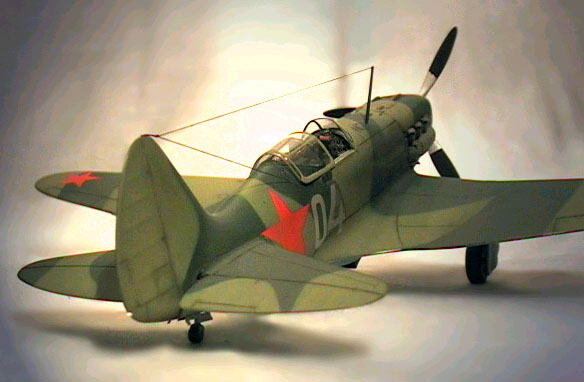

.jpg)
